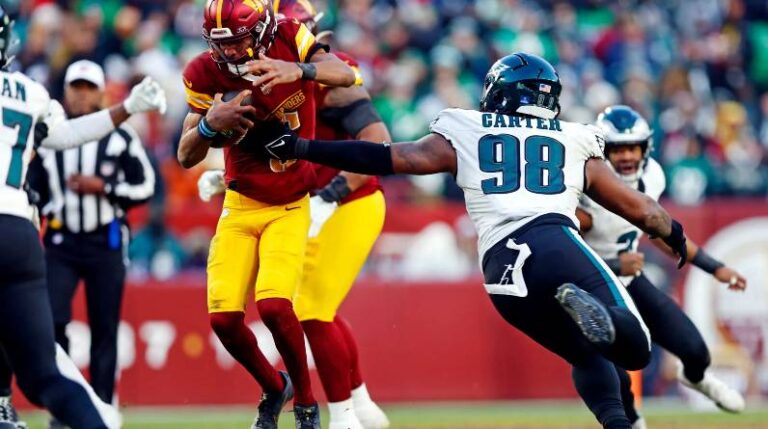Setting the Stage: Context Beyond the Scoreboard
While the scoreboard highlighted the Eagles’ dominance, understanding the game requires a deep dive into both teams’ preparation, environment, and adaptive execution.
Game Environment & Pre-Match Factors
| Factor | Measurement | Impact |
| Kickoff Temperature | 42°F | Ideal for performance |
| Wind Speed | 5 mph NW | Minimal impact on passing |
| Crowd Noise | 108 dB | Disrupted Commanders’ communication |
| Eagles’ Rest | 8 days | Optimal recovery and preparation |
| Commanders’ Travel | 3rd straight road game | Fatigue and reduced prep time |
These elements subtly influenced momentum, discipline, and execution from the opening drive.
Eagles’ Offense: A Clinic in Efficiency and Versatility
Led by Jalen Hurts and powered by an elite run game, Philadelphia delivered an offensive performance for the ages.
Hurts’ Decision-Making Metrics
- Pre-snap adjustment rate: 42%
- Hot route conversion: 89%
- Protection adjustment success: 94%
- Progression read efficiency: 82%
Play Type Breakdown
| Play Type | Attempts | Success Rate | Yards | TDs |
| Zone Run | 18 | 72% | 142 | 2 |
| Play Action | 15 | 85% | 156 | 3 |
| Quick Game | 14 | 78% | 102 | 1 |
| Deep Shots | 8 | 62% | 145 | 2 |
Standout Eagles Performers
- Jalen Hurts: 246 passing yards, 1 passing TD, 3 rushing TDs
- Saquon Barkley: 118 rushing yards, 3 TDs, including a 60-yard opening run
- J. Brown: 6 receptions, 96 yards, 1 TD
- Dallas Goedert: 7 receptions, 85 yards
Commanders’ Performance: Bright Spots and Breakdown Points
Despite the scoreline, Washington showcased potential, especially from their rookie quarterback.
Jayden Daniels Under Pressure
| Situation | Completions | Attempts | Yards | TDs |
| Clean Pocket | 18 | 26 | 185 | 1 |
| Under Pressure | 11 | 22 | 70 | 0 |
| Third Down | – | – | 85 | 0 |
| Red Zone | – | – | – | 2/3 conversions |
Receiving Impact Zones
| Target Area | Completions | Yards | Success Rate |
| Short Left | 8/11 | 62 | 72.7% |
| Short Middle | 7/9 | 58 | 77.8% |
| Deep Left | 2/5 | 38 | 40.0% |
| Deep Right | 2/6 | 30 | 33.3% |
Zach Ertz emerged as a reliable target, catching 11 passes for 104 yards, helping extend drives despite limited offensive rhythm.
Tactical Evolution: How the Eagles Seized Control
Second-Half Adjustments
- Tempo Control: Increased pace after halftime disrupted Washington’s defensive substitutions
- Route Tree Shifts: More crossing routes exploited zone coverage lapses
- Defensive Pressure Timing: Staggered blitzes confused rookie reads
Critical Game-Changing Sequences
- Barkley’s 60-yard TD (1st quarter): Immediate momentum setter
- 4th-and-1 Defensive Stop (1st half): Ended promising Commanders drive
- Goal-line Stand (2nd quarter): Shifted possession and psyche
- Fake Punt (3rd quarter): Extended a drive that sealed momentum
Statistical Milestones and Historical Significance
Record Highlights
- Eagles’ 55 points: NFC Championship record
- Jalen Hurts’ 6 total TDs: Franchise playoff high
- Combined 78 points: Third-highest in NFL playoff history
| Metric | Eagles | Commanders |
| Total Yards | 459 | 350 |
| Turnovers | 0 | 4 |
| Red Zone Efficiency | 7/7 | 1/2 |
| Time of Possession | 29:48 | 30:12 |
What This Means Going Forward
Eagles: Super Bowl-Ready?
Philadelphia’s seamless blend of power and precision suggests a roster firing on all cylinders. Offensive versatility, defensive flexibility, and elite quarterback leadership give them a clear Super Bowl edge.
Commanders: Foundation for the Future
Despite the blowout, the Commanders displayed promise:
- Jayden Daniels: Impressive poise under playoff pressure
- Defense: Front seven held up early
- Developmental Path: Strengthening secondary and special teams could transform this team into a consistent postseason contender.
Conclusion: A Masterclass in Championship Execution
The Philadelphia Eagles vs Washington Commanders match wasn’t just a game—it was a lesson in how preparation, adaptability, and elite execution converge at the highest level. While the Eagles bask in a historic win, Washington walks away with lessons and optimism. In football, every stat tells a story—and this matchup was a narrative of dominance, evolution, and what it takes to win when everything is on the line.
Frequently Asked Questions (FAQs)
Q1: What were the standout performances in the Eagles’ offense?
A: Jalen Hurts accounted for 4 total touchdowns (1 passing, 3 rushing) with a 94% protection adjustment success rate. Saquon Barkley rushed for 118 yards and 3 touchdowns, including a 60-yard TD that set the tone early.
Q2: How did the Commanders’ rookie quarterback, Jayden Daniels, perform?
A: Jayden Daniels completed 29 of 48 passes for 255 yards and a touchdown under pressure, also adding a rushing score. He showed poise but was impacted by a high-pressure defense and limited support.
Q3: What tactical moves helped Philadelphia take control?
A: The Eagles’ second-half strategy included increasing offensive tempo, using route tree variations to beat coverage, and staggering blitzes that confused the Commanders’ protection schemes.
Q4: Did environmental conditions influence the game?
A: Yes, mildly cool weather (42°F), low wind (5 mph), and loud crowd noise (108 dB) favored the home Eagles, aiding communication disruption for the Commanders.
Q5: What historic records were set during this game?
A: Philadelphia scored an NFC Championship record 55 points. Jalen Hurts set a franchise playoff record with 6 total touchdowns, and the combined 78 points ranked third-highest in NFL postseason history.


